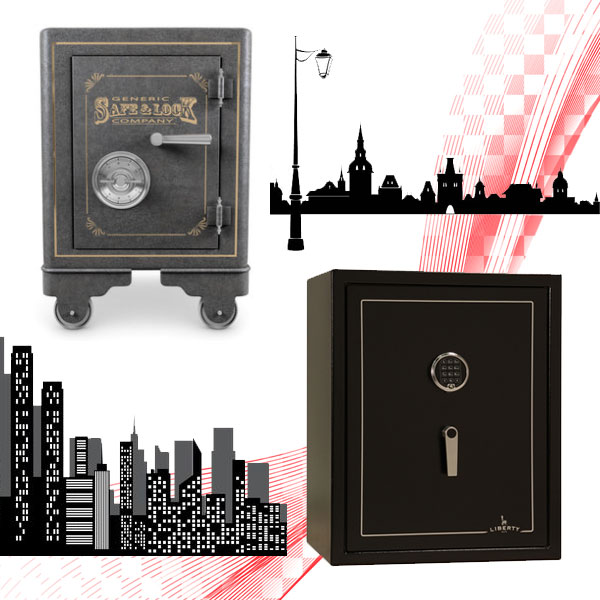Modern vs antique safes: which are more reliable?
Antique and modern safes have their strengths and weaknesses in terms of reliability, and there is no clear answer to the question of which of them is more reliable. Everything depends on the specific model, its protection class and how and when it was made. The history of the creation of metal safes goes back several hundred years. At first, they were barrel-shaped and equipped with a padlock. In 1835, English inventors Charles and Jeremiah Chubb from Wolverhampton, England, received a patent for a burglar-resistant safe and began their production. From this point on, we can talk about the industrial production of metal safes in Europe.
The history of the creation of metal safes goes back several hundred years. At first, they were barrel-shaped and equipped with a padlock. In 1835, English inventors Charles and Jeremiah Chubb from Wolverhampton, England, received a patent for a burglar-resistant safe and began their production. From this point on, we can talk about the industrial production of metal safes in Europe.In North America, one of the first significant manufacturers of metal safes was Herring & Co. Silas C. Herring purchased the patent for the fireproof safe "Salamander" from its inventor Enos Wilder in 1826. Herring began actively improving the design and developing production, opening factories and sales offices in the United States. His company played a key role in the development of the metal safe industry in North America, especially in terms of fire resistance. Later, in 1867, Hall's Safe & Lock Company was founded, which also became a large and influential manufacturer of safes and locks in the United States.
As for the production of burglar-proof safes in North America, there are several key points to highlight:
Until the mid-19th century: The main emphasis was on fire resistance. Safes were reinforced with metal elements, but there were fewer targeted patented solutions specifically to resist burglary.
From the mid-19th century: With the rise in crime and the development of burglar skills, manufacturers began to actively develop and patent mechanisms and designs aimed specifically at increasing burglary resistance.
After a short historical background, let's try to compare safes.
So, antique safes:
Advantages:
Massiveness and thickness of metal: Many antique safes were made of very thick steel, which made them resistant to rough breaking with the mechanical tools of the time.
Complex mechanical locks: Some old safes were equipped with multi-stage mechanical locks with high security, which were difficult to pick or drill without special knowledge and tools.
Uniqueness of design: Often, antique safes were made by hand, which made their designs unique and less predictable for burglars.
Aesthetic value: Many antique safes are works of art and can be very valuable in themselves, which speaks to the quality of their manufacture.
Disadvantages:
Vulnerability to modern tools: The steel of old safes may not be as strong as modern alloys, and they may be more vulnerable to tools such as a thermal drill or an oxyacetylene torch.
Wear of mechanisms: Over time, mechanical locks can wear out, which can lead to their breakdown or reduced reliability.
Lack of modern technology: Old safes, naturally, do not have modern security systems, such as alarms, motion sensors or electronic locks with protection against code selection.
Modern safes:
Advantages:
High-strength materials: Modern safes are made of alloy steels and composite materials that are highly resistant to mechanical and thermal impacts.
A variety of protection classes: There is a clear classification of modern safes by the level of burglary resistance, which allows you to choose a model with the required degree of protection.
Modern locking systems: Modern safes are equipped with complex mechanical, electronic or combination locks with different levels of secrecy and protection against manipulation.
Additional security systems: Many modern safes can be equipped with alarms, shock and vibration sensors, and blocking systems in case of a break-in attempt.
Fire Resistance: Modern safes often have some level of fire resistance, protecting the contents from high temperatures in the event of a fire.
Disadvantages:
Mass Production: Some modern safes may be more standardized, potentially making the job easier for experienced burglars who are familiar with certain models.
Reliance on Electronics: Electronic locks may be vulnerable to electronic attacks or failure due to power supply issues.
In general, modern, high-security certified safes tend to provide a higher level of security due to the use of modern materials, technology, and multi-layered security systems. However, some well-preserved vintage safes with massive construction and complex mechanical locks may also pose a serious obstacle for burglars, especially if they are using older methods of breaking in.
When choosing a safe, whether it is antique or modern, it is important to pay attention to its burglar resistance class, the quality of the locking system and the reputation of the manufacturer. If you are considering an antique safe, you need to make sure that its mechanisms are in good working order and evaluate its resistance to modern burglary methods. For maximum reliability, modern safes are often the preferred option.

